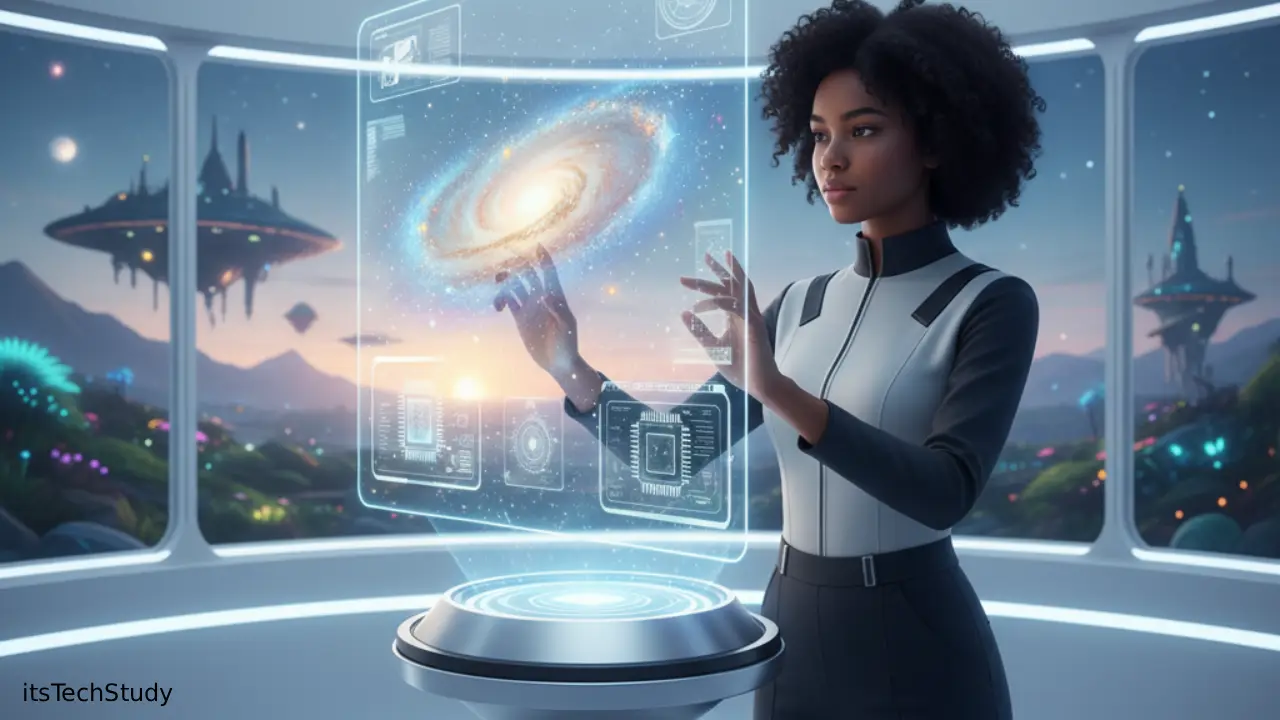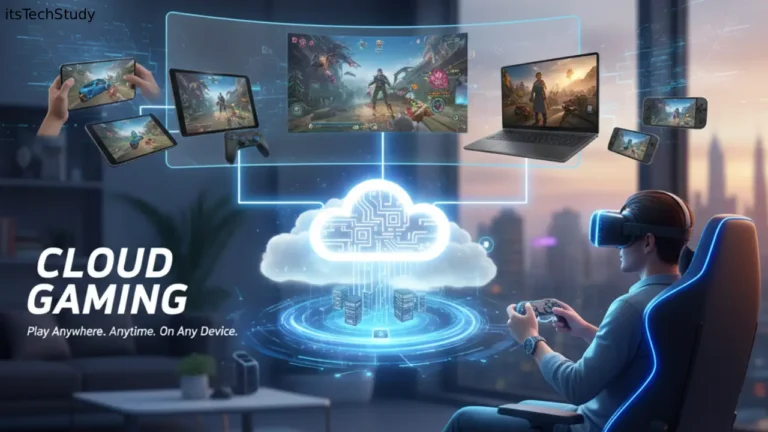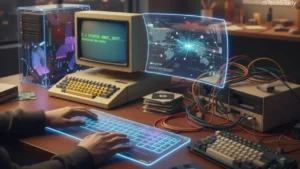Introduction: The Rise of Holographic and 3D Technology
Imagine walking into a store and seeing a life-sized hologram of a product floating in mid-air – or attending a concert where your favorite artist performs in holographic form right before your eyes. This isn’t science fiction anymore; it’s the fast-emerging reality powered by holographic displays and 3D technology.
Over the last decade, display technology has undergone a massive transformation – from bulky cathode-ray TVs to ultra-thin OLED panels, and now to immersive holographic and 3D projections. But what makes these technologies so groundbreaking? They don’t just display images; they bring them to life.
Today, industries like entertainment, healthcare, education, retail, and design are leveraging holographic and 3D visualization to create next-gen experiences – experiences that engage, inform, and inspire. However, with innovation comes complexity: cost, technical limitations, and integration challenges. Understanding how to use holographic displays and 3D technology effectively can unlock new possibilities in digital storytelling, virtual interaction, and product visualization.
Let’s dive deep into how these technologies work, how they’re used, their advantages and challenges, and what the future holds for truly immersive experiences.
Understanding Holographic Displays: A New Dimension of Visualization
Holographic displays are systems that project three-dimensional images visible to the naked eye — no special glasses required. Unlike 2D screens, holograms use light diffraction to create the illusion of depth, allowing users to view objects from multiple angles.
How Holographic Displays Work
- Light Interference – Holograms record light waves reflected from an object and use interference patterns to recreate them.
- Laser Projection – Lasers project and reconstruct the image using these patterns, forming a visible 3D model.
- Dynamic Rendering – With digital holography, computers dynamically render 3D images, making holographic displays interactive and real-time.
These displays are now powered by AI, IoT, and AR integrations, enabling them to react to user inputs and environmental data — creating highly interactive experiences.
The Role of 3D Technology in Modern Digital Transformation
3D technology extends beyond entertainment; it underpins industrial design, gaming, medical imaging, and virtual collaboration. It allows digital objects to exist in a spatial environment, mimicking real-world interaction.
Core Elements of 3D Technology
- 3D Modeling: Designing objects with spatial dimensions (X, Y, Z axes).
- 3D Scanning: Capturing real-world objects and converting them into digital form.
- 3D Rendering: Generating realistic visuals using lighting, texture, and perspective.
- 3D Projection: Displaying the visuals through VR headsets, AR glasses, or holographic devices.
Together, holography and 3D create immersive, interactive experiences that blend the virtual and physical worlds seamlessly.
Comparing Traditional Displays vs. Holographic Displays
Here’s a quick look at how holographic displays outperform traditional 2D displays across several parameters:
| Feature | Traditional Displays (2D) | Holographic Displays (3D) |
|---|---|---|
| Visual Depth | Flat images | Realistic depth perception |
| User Interaction | Limited | Fully interactive |
| Viewing Equipment | Requires screens | Glasses-free 3D visualization |
| Immersion Level | Moderate | Extremely immersive |
| Applications | TVs, monitors, phones | AR/VR, education, medical, retail |
| Engagement Factor | Passive | Active, engaging experience |
The difference is clear: holographic displays provide an unparalleled depth and realism that makes content not just visible but tangible.
Applications of Holographic Displays and 3D Technology
These technologies are reshaping multiple sectors, pushing boundaries of imagination and utility.
1. Entertainment and Media
From movies to gaming, holography adds depth to storytelling. Virtual concerts, 3D gaming environments, and immersive cinematics are redefining audience engagement.
2. Education and Training
Students can now interact with holographic models of the solar system or human anatomy. This hands-on approach enhances learning and retention significantly.
3. Healthcare and Medicine
Surgeons use holographic imaging for precise visualization of organs and tissues before and during operations. 3D medical imaging also aids diagnosis and patient education.
4. Retail and Advertising
Brands deploy holographic displays for interactive product showcases and virtual shopping assistants, creating memorable customer experiences.
5. Architecture and Real Estate
3D visualization helps architects present lifelike designs, allowing clients to “walk through” spaces before construction even begins.
6. Defense and Aerospace
Holographic mapping and 3D simulation assist in mission planning, navigation, and pilot training with high accuracy and safety.
Advantages of Using Holographic Displays and 3D Technology
Pros
- Immersive Experiences: Offers a realistic and interactive visual environment.
- Enhanced Learning: Aids better understanding in educational and professional training contexts.
- Increased Engagement: Boosts customer interaction and brand recall.
- Innovative Marketing: Creates futuristic displays for promotions and events.
- Real-Time Collaboration: Facilitates virtual meetings with lifelike avatars and objects.
Cons
- High Initial Cost: Advanced equipment and projection systems are expensive.
- Technical Complexity: Requires powerful hardware and precise calibration.
- Limited Content Availability: Producing quality 3D or holographic content is resource-intensive.
- Environmental Constraints: Ambient light can reduce holographic visibility.
- Maintenance Needs: Sensitive to dust, alignment, and environmental conditions.
How To Use Holographic Displays and 3D Tech for Next-Gen Experiences
Using holographic displays effectively involves a blend of creativity, technology, and strategic implementation. Here’s how businesses and creators can leverage it:
1. Define Your Objective
Decide the purpose – education, marketing, entertainment, or visualization. The clearer your objective, the better your execution.
2. Choose the Right Hardware
Select from types like Pepper’s Ghost, Light Field Displays, or Digital Holograms depending on the depth and realism you need.
3. Create Engaging 3D Content
Use tools like Unity, Blender, or Unreal Engine to design high-quality holographic content that’s visually striking and responsive.
4. Integrate with AR/VR Platforms
For hybrid experiences, combine holographic visuals with AR or VR environments to enhance interactivity.
5. Optimize for Real-Time Interaction
Incorporate AI-based gesture and motion sensors to make holograms respond to user movement and voice commands.
6. Test Across Environments
Lighting, angle, and distance all affect display quality. Always test in real-world conditions before deployment.
7. Monitor and Update Content
Dynamic holographic systems thrive on freshness — update visuals regularly to maintain engagement and relevance.
Industry Case Studies: Where It’s Already Working
HoloLens by Microsoft
Combines holography and AR for collaborative 3D modeling and remote support across industries like design and healthcare.
Looking Glass Factory
Develops glass-free holographic displays for developers and artists, offering real-time 3D visualization.
Holoxica (UK)
Uses medical holography for 3D anatomical visualizations, helping doctors understand patient scans better.
Epic Games & Unreal Engine
Empowers creators with realistic 3D holographic rendering for gaming, film, and industrial use.
The Future of Holographic Displays and 3D Technology
The future is heading toward fully interactive holographic ecosystems — where users can project, manipulate, and communicate through lifelike 3D holograms. As AI and quantum computing evolve, holography will gain even higher resolution, real-time adaptability, and lower latency.
Predicted Trends for the Next 5 Years
- Mass Adoption in Education: Holographic classrooms for remote, interactive learning.
- Holographic Retail Assistants: Personalized hologram-based customer interaction.
- Holo-Meetings: Realistic, 3D telepresence replacing video conferencing.
- Wearable Holography: Portable projection devices and smart glasses.
- AI-Driven Holographic Rendering: Smarter, faster holographic computations.
Key Benefits for Businesses
- Brand Differentiation: Create memorable, futuristic experiences.
- Better Product Visualization: Display prototypes in 3D without physical samples.
- Cost-Efficient Training: Reduce travel and setup costs with holographic simulations.
- Customer Retention: Interactive displays foster stronger emotional connections.
Potential Challenges and How to Overcome Them
| Challenge | Solution |
|---|---|
| High Setup Costs | Start small with portable holographic displays and scale gradually. |
| Content Creation Barriers | Partner with 3D designers or use AI-based rendering tools. |
| Technical Skills Gap | Offer team training or hire specialists. |
| Market Acceptance | Run pilot demos to showcase benefits and attract stakeholders. |
Conclusion: Shaping the Future of Human Interaction
Holographic displays and 3D technology are redefining how we interact with digital information – turning flat screens into living, breathing experiences. From education and entertainment to healthcare and retail, these innovations are bridging the gap between imagination and reality.
As accessibility improves and hardware costs fall, we’re moving toward an era where holographic communication becomes as normal as video calls today. The possibilities are limitless – and those who learn how to use these technologies effectively will lead the next wave of digital transformation.
So, whether you’re a business owner, educator, or innovator, now’s the time to explore the world of holographic displays and 3D technology – and bring your ideas to life in ways the world has never seen before.
Frequently Asked Questions (FAQ)
Q1: What is the difference between holographic and 3D technology?
Ans: Holography creates real 3D light fields visible without glasses, while 3D technology often needs special equipment or screens to simulate depth.
Q2: Are holographic displays expensive?
Ans: Yes, high-end holographic systems are costly, but prices are dropping as the technology matures and scales commercially.
Q3: Can I create holographic content at home?
Ans: Basic holographic effects can be created using smartphones and DIY projection kits, but professional holography requires specialized tools and software.
Q4: How is 3D technology used in education?
Ans: 3D and holographic models make complex subjects like anatomy, architecture, and physics easier to understand through interactive visual learning.
Q5: What are some leading companies in holographic technology?
Ans: Major players include Microsoft (HoloLens), VividQ, Looking Glass Factory, Holoxica, and RealView Imaging.
Q6: What’s the biggest limitation of holographic displays?
Ans: The biggest challenge is balancing visual quality and cost — high-quality holograms need advanced optics and processors that can be expensive.












No Comments Yet
Be the first to share your thoughts.
Leave a Comment